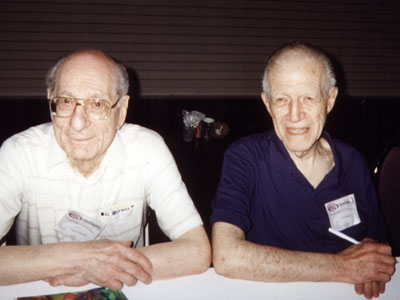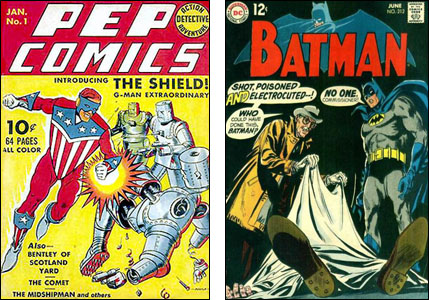
Another great comic book artist of the medium's first generation has died. Irv Novick, seen in the above photo with his longtime editor Julius Schwartz, passed away this morning following a long illness and a recent fall. He was 88 years old and had been drawing comics, pretty much without stopping, from 1939 until his retirement more than fifty years later. He was a graduate of the National Academy of Design. In '39, he worked briefly in the studio of Harry "A" Chesler, who paid low rates to young illustrators who cranked out pages in what Novick later called a "sweat shop atmosphere." Everyone told Novick he was good enough to get work on his own…and after a few months, he did. He was hired by MLJ (now known as Archie Comics) and his first-known work there was in Blue Ribbon Comics #2 (December, 1939) where his art introduced a new character, Bob Phantom, who stuck around for many years. The next month, he did the cover and lead story of Pep Comics #1, which debuted The Shield, the first "patriotic" super-hero. Written by Harry Shorten, The Shield predated Captain America, offering a similar premise and — because both heroes wore the American flag — similar costume.
Thereafter, Novick was MLJ's lead superhero artist, drawing all their major costumed characters at one time or another, including The Hangman and Steel Sterling, until they began cutting back on heroes and increasing their Archie titles around 1946. From '46 to '51, he worked on two syndicated strips — Cynthia and The Scarlet Avenger — neither of which achieved wide circulation. He also began working intermittently in advertising but that wasn't steady so he started drawing for DC, hired by editor Robert Kanigher, who had written many of the stories he'd drawn for MLJ. Kanigher was the DC war editor so Novick became a war artist, his work appearing in Our Army at War and all the DC combat titles, and occasionally in the romance books during the occasional periods when Kanigher worked on them. Kanigher had a reputation for being rough on artists but he loved Novick's work and, according to Irv, they never had a cross word in all their years of working together.
For many years, Novick drew for DC and also freelanced for Boys' Life magazine and for the Johnstone-Cushing advertising agency. In the mid-sixties, the agency offered him a full-time position and he briefly left comics. Novick was unhappy in the job and Kanigher was unhappy to lose one of his two favorite artists, Joe Kubert being the other. With Kanigher's intervention, Novick landed a then-unprecedented freelance contract with DC. It included many perks not available to other artists and guaranteed him the company's highest rate and steady work. When he finished one job, he had to immediately be given another. Kanigher had no trouble keeping him busy, though other artists complained that assignments promised to them would sometimes be suddenly diverted to Irv. After 1968 when Novick began working for other DC editors, there was sometimes a wild panic in the company's office: "We have to find a script to give Irv tomorrow!" The one story I wrote that Novick drew came about in part because editor Julius Schwartz needed something to keep Novick busy. (By that time, many artists had such contracts but Novick was the first.)

1968 was when artist Carmine Infantino was promoted into management at DC and charged with improving the look of the company's line. One of his first decisions was to rotate artists around, breaking up old editorial holds on certain talent. Novick stopped pencilling and inking war titles and became a full-time superhero penciller. His immediate tasks were Batman and Lois Lane but he eventually drew most of the top DC titles, including a long stint on The Flash. He only cut back as his eyes failed him in the late nineties.
I was honored and frustrated to interview Irv on several convention panels over the years — an impossible task, for in front of an audience and microphone, he claimed to remember very little of his career and to have absolutely no fondness for any job or character over any other. Apart from a mild preference for working with his friend and neighbor, Bob Kanigher, he insisted it didn't matter. "I just drew what they gave me to draw," he'd say. "If it was Batman or Captain Storm or Flash…I didn't care." Some of his contemporaries would chide him for saying such things, for they'd seen the care and effort that went into Novick's pages…and in private, talking one-on-one with the man, you wouldn't get quite such a noncommittal attitude. And of course, you'd know it wasn't true when you looked at his art. I'm going to miss seeing him at conventions and trying with no success to get a decent answer out of the guy. He leaves behind an amazing body of top-notch comic illustration.